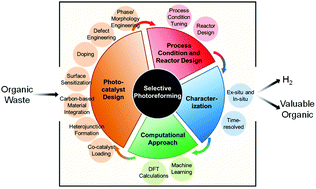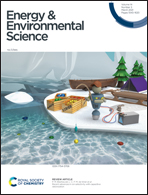Advancing photoreforming of organics: highlights on photocatalyst and system designs for selective oxidation reactions
Abstract
Photoreforming is a process that harnesses the redox ability of photocatalysts upon illumination, to simultaneously drive the reduction of H+ into hydrogen gas and oxidation of organic compounds. Over the past few decades, significant effort has been devoted to improving the photocatalytic hydrogen evolution efficiency, while substantially less focus has been directed towards the oxidation reactions. More recently, the realization of the potential for simultaneous hydrogen production with value-added organics has inspired researchers to use photooxidation pathways to tune the selectivity of oxidized products. As a distinct benefit, the less energetically demanding organic reforming is highly favorable when compared to the slow kinetics of oxygen evolution which negates the need for expensive and/or harmful hole scavengers. Photocatalyst modifications, such as secondary component deposition, doping, defect, phase and morphology engineering, have been the main strategies adopted to tune the photooxidation pathways and oxidation products. Direct control of the process conditions, including pH, temperature and reactant concentration, and favorable reactor designs can further improve the selectivity towards desired products. While other published reviews focus on the types of photocatalysts or feedstocks used to enhance the hydrogen evolution efficiency, this review highlights the importance of controlling the selectivity of the photoreforming reaction, particularly as an alternative path for waste abatement or valorization for industry. This review links the strategies used to improve the selectivity of photoreforming of organic waste into high-value and desirable chemicals, as well as offers an outlook on the future research direction required to deliver highly selective photocatalyst. A holistic strategy that comprises photocatalyst and system designs, appropriate characterizations and implementation of artificial intelligence has also been proposed and discussed to further aid establishment of the structure–mechanism–function relationship, thereby accelerating the discovery of optimum selective photoreforming systems.



 Please wait while we load your content...
Please wait while we load your content...